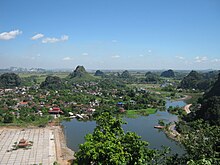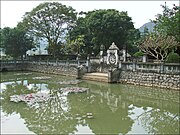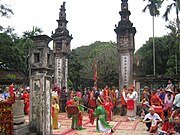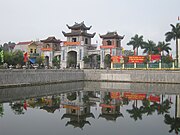Hoa Lư






Hoa Lu Ancient Capital (Vietnamese: Cố đô Hoa Lư) was the economic, political and cultural center of Dai Co Viet (10th century Vietnam). It is also the native land of 3 royal dynasties: the Dinh, Early Le and Ly. The ancient capital covered an area of 300 ha (3.0 km2), including both the Inner and Outer Citadels. It was surrounded by rock mountain ranges. In the past, Hoa Lu Royal citadel was adorned with splendid palaces, magnificent temples and shrines. When King Ly Cong Uan transferred the capital to Thang Long (now known as Hanoi), it became the ancient capital. Due to the ravages of time, Hoa Lu Ancient Citadel no longer exists. Now, there are only some vestiges related to the Dinh, Le and Ly dynasties. For example, there is King Dinh temple for worshipping King Dinh Tien Hoang and his sons, Le Temple worshipping King Le Dai Hanh, Queen Duong Van Nga and their sons.[1] old capital of Hoa Lu in the center of Ninh Binh province, where 90 km away from Hanoi.
Hoa Lu Ancient Capital, with Phat Diem Church, Tam Coc - Bich Dong, Bai Dinh Pagoda, Trang An, and Cuc Phuong, is the destination of Ninh Binh province.
Remains in the area
The ancient imperial capital Hoa Lu contains 47 monuments. The most important of the monuments are: Le Dai Hanh Temple, Dinh Tien Hoang Temple, Noi Lam Temple, Bai Dinh Temple, Thien Ton Cave, Trang An Grottoes, Ban Long Pagoda,...
Temple of Emperor Dinh Tien Hoang
The Temple is located in Truong Yen Thuong village, Truong Yen Commune, Hoa Lu district. Hoa Lu residents built this temple to worship Emperor Dinh Tien Hoang, who is from this town. Born into a peasant family, he came into military prominence and became a powerful warlord and he ultimately defeated the other twelve rival feudal warlords. He unified the country and founded the first centralized feudal dynasty in Vietnam.[2]
The temple is located on the ground of the former main palace of the royal citadel. It is easy to note that the location is in the “tien thuy hau son” style incorporating feng shui (A river at the front and a mountain at the back). The temple was designed in the “noi cong ngoai quoc” style.
Temple of Emperor Le Dai Hanh
The temple is located in Truong Yen Ha Village, Truong Yen Commune, Hoa Lu District. It is 200m from Emperor Dinh Tien Hoang Temple to the north, the temple has Den Mountain as a backdrop. The features of architecture, art and devotional statues are similar to those of Emperor Dinh Tien Hoang's Temple. The temple still retains its original architectural beauty. The constructions does not have stone-doorsteps and stones for propping the pillar as Emperor Dinh Tien Hoang's Temple. Hence, we can contemplate the temple with adequate example of the architecture and sculpture of Post-Le Dynasty period.[3]
The “Chinh Cung” part of Emperor Le Dai Hanh Temple comprises five structural chambers. The middle chamber has statue of Emperor Le Dai Hanh sitting on his throne, wearing a Binh Thien Hat and his face is very hale and hearty. The statue is placed on a pedestal. There is also a statue of Empress Duong Van Nga in the temple. This proves that the local residents have sympathy with the woman who was the wife of these two different Emperors. Her statue is placed on the left side of Emperor Le Dai Hanh's Statue. The statue of Empress Duong Van Nga is beautiful artistically showing a plump and charming face, ruddy skin and many features of contemporary Viet women in those time. Her outer robe is sculpted with supple creases, be loosened to reveal the inside blouse with many noble-patterns. Her statue displays feminine virtues and youthful qualities that reflects an image of a enthusiastic, talented, keen and beautiful woman.
Nhat Tru Pagoda
Head First Temple by Emperor Le Dai Hanh for construction. Later, Emperor Ly Thai Tong also built Temple in Hanoi like this temple. The temple also holds many artifacts from 10th and 11th Century. One of the most prominent piece of architecture is the stone pillar in the temple courtyard, this column recorded the history of temple building.
Daughter of King Dinh Tien Hoang Temple
This is a small temple near Nhat Tru Pagoda. This temple is dedicated to daughter of Emperor Dinh Tien Hoang. When Dinh Tien Hoang recruited a talented court official Ngo Khanh, he married the princess to Khanh. However, this court official and the princess ran off to the neighboring kingdom of Champa to the south. A year later, she managed to return home to the imperial court, but was thrown in prison as a punishment and she was eventually sent off to Nhat Tru Pagoda to be a nun. When her father Emperor Dinh Tien Hoang was assasinated in 979, the princess committed suicide died by jumping into a well nearby the pagoda. The pagoda institution afterwards dedicated the well in her honor.
Thien Ton Cave
Legend has it that Dinh Bo Linh ventured into this cave and received his oracle while he was at war with twelve rival warlords. He made offerings to the local deity who supposed gave him an oracle that he would conquer and defeat all his warlord enemies in the end. Finally in 968, Dinh Bo Linh defeated all twelve warlords and unified Annam (Vietnam).[4]
The entire cave area still has a serene scene with many fruit trees. Thien Ton Cave has two chambers, the outer chamber is large while the inner one is narrower. The outer chamber of the cave is dedicated to the worship of Buddha; the inner cave is where immortals are venerated. Thus, Thien Ton is both a bi-religious complex where it consists of Buddhist elements on the outer chamber and a Daoist element in the inner complex. There are many valuable objects displayed inside the cave, for example the bell cast during the reign of Emperor Le Hien Tong, the Thien Ton Statue and groups of lacquered and gilded Buddhist statues. The unique feature of Thien Ton Cave is that all the worshipping objects and architectural details including the pillars, and the altars are made of decorated into the rocks with stylized images of dragons, the motifs of the Ly dynasty.
Hoa Lu ancient capital festival
Hoa Lu ancient capital Festival opened in the spring. Start a ceremony at the Yellow River Long procession of the temple 2 Kings. Group stage near the procession of King Dinh Tien Hoang Temple. There will be many games in the Assembly. Hoa Lu Festival described the history of Vietnam from 968 to 1010 with many changes.
Photos of Hoa Lu Ancient Capital
See also
References
External links
- Hoa Lu ancient capital
- Dinh Tien Hoang Temple
- Hoa Lu Ancient capital
- Ninh Binh holds Hoa Lu ancient capital festival
- Hoa Lu Ancient Capital





